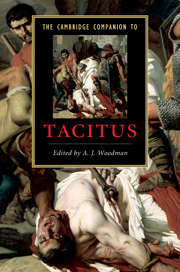Book contents
- Frontmatter
- Introduction
- Part I Contexts
- Part II Texts
- Part III Topics
- 10 Tacitus’ personal voice
- 11 Tacitus as a historian
- 12 Res olim dissociabiles: emperors, senators and liberty
- 13 Style and language
- 14 Speeches in the Histories
- 15 Warfare in the Annals
- Part IV Transmission
- Chronological table
- Abbreviations and bibliography
- Index
12 - Res olim dissociabiles: emperors, senators and liberty
from Part III - Topics
Published online by Cambridge University Press: 28 March 2010
- Frontmatter
- Introduction
- Part I Contexts
- Part II Texts
- Part III Topics
- 10 Tacitus’ personal voice
- 11 Tacitus as a historian
- 12 Res olim dissociabiles: emperors, senators and liberty
- 13 Style and language
- 14 Speeches in the Histories
- 15 Warfare in the Annals
- Part IV Transmission
- Chronological table
- Abbreviations and bibliography
- Index
Summary
The relationship of the emperors to the senate is one of Tacitus' most important themes; and a striking feature of his writing, particularly of the Annals, is the large amount of space devoted to senatorial matters, especially the writing of obituaries and the recording of motions, sometimes proposed by men of little consequence. Power in the Roman Republic had been diffused between magistrates, senate and people. Polybius (6.10-18) saw an ideal, balanced constitution, but his and Livy's work allows the inference that after the Second Punic War the senate was the dominant force in the body politic. In the late Republic its power declined in the face of a resurgent populace and the ruthless ambition of magistrates and pro-magistrates. The Principate brought further decline, since Augustus' determination to remove the political conditions that had allowed his own rise meant that, inter alia, the collective will of the aristocracy had to be curbed. With him the senate made, almost unconsciously, a kind of Faustian pact: in return for massively enhanced dignity it surrendered much of its capacity to initiate actions of any real consequence. Augustus and Tiberius made much of consulting the senate, but their dominance rested more on an iron grip on the legions than on senatorial support.
- Type
- Chapter
- Information
- The Cambridge Companion to Tacitus , pp. 184 - 194Publisher: Cambridge University PressPrint publication year: 2010
- 2
- Cited by

